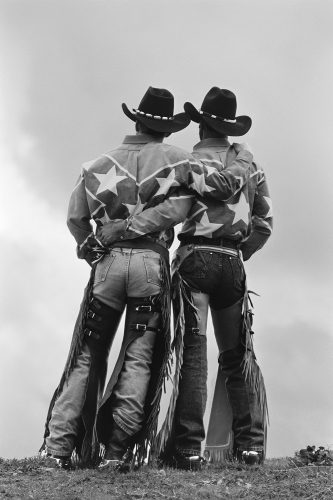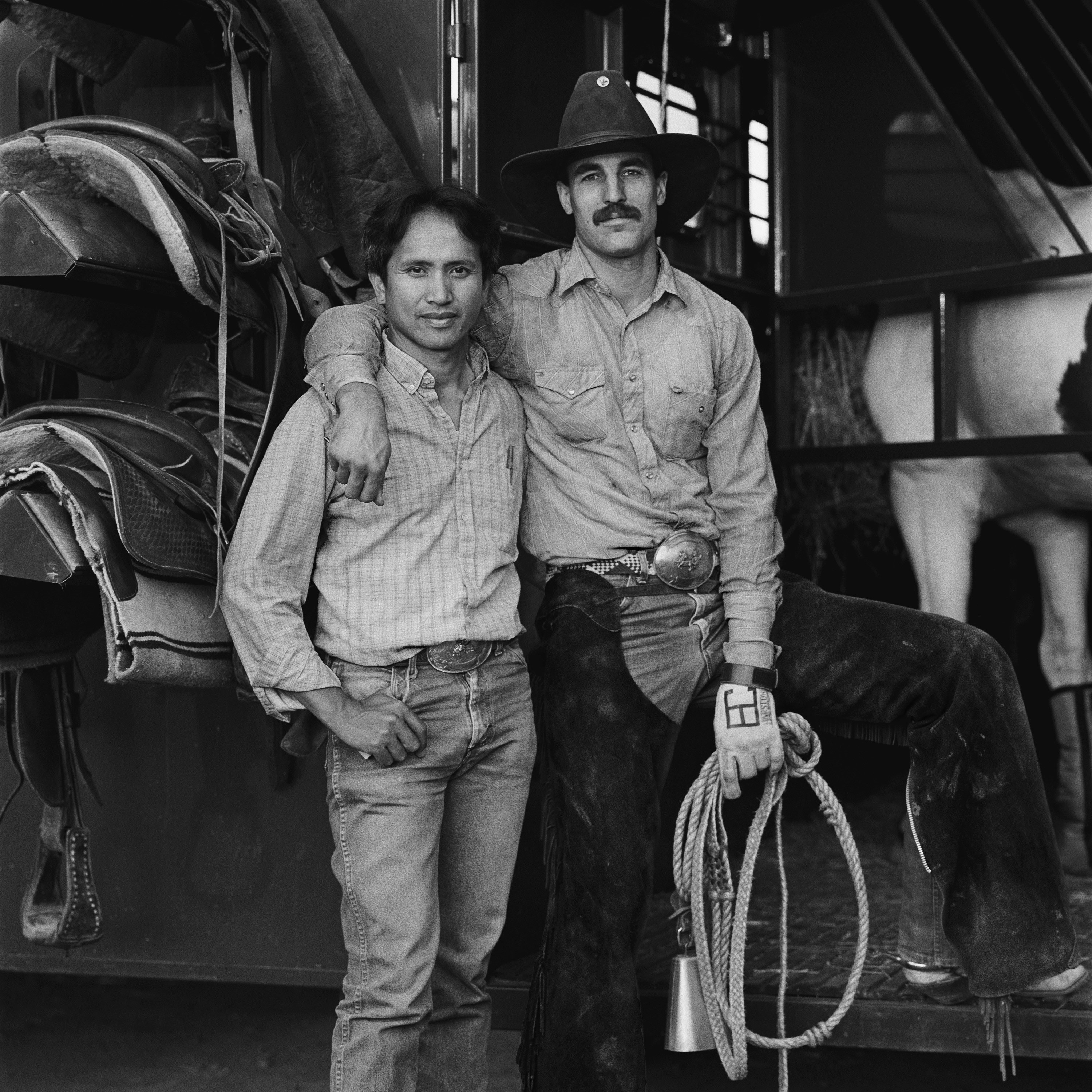
I should have heard about the gay rodeo. It’s been around more than 40 years, and many of the shots in “Blake Little: Photographs from the Gay Rodeo,” an exhibit that opens Saturday, Sept. 7, and runs through Jan. 19 at the University of Oregon’s Museum of Natural and Cultural History, are from my hometown, Los Angeles.
I could talk about Little’s 41 photographs in relation to their tones and value, addressing how the decision to work in black and white lends an archival feel to the subject. I could write about the photographs in terms of elements of art; their strong sense of design and dynamic presence, especially in those images that capture the act of riding or roping, of people and animals in motion, struggling with each other.
I’m more interested in the content.
The group portrait in the show is called “Los Angeles Cowboys, Hollywood, California” (1990). And “Rodeo Partners Gene Hubert and Rick Ferreira, Sun Valley, California” (1991) is a standout (Sun Valley is a suburb of L.A.). It depicts two cowboys with their arms around each other. One has his arm around the other’s waist. It’s not that different of an image from one you might see at a “regular” rodeo — a variation on a tradition.
All the photographs in Little’s exhibit cover the years from 1988 to 1992. They range in locations from Oklahoma to California.
According to Utah folklorist Craig Miller, who will speak Oct. 24 at the museum, the first gay rodeo in the U.S. took place in 1976. It coincided with the migration of young gay people moving west — or east — from rural areas to urban ones. That was a year before Harvey Milk, the country’s first openly gay official, was elected to office in San Francisco — and two years before he was assassinated.
I spoke with Miller by phone from Utah. He said his work as a folklorist working for the state of Utah was the best job you could have. He traveled the state talking to Native American groups, Mormons, ranchers and other ethnic communities about their traditions.
Was he introduced to the gay rodeo in his travels as a folklorist?
No, he said. Cowboys he met in gay bars in Salt Lake City introduced him to the event.
“This is incredible,” he thought when he first attended.
In 1993 he presented a paper on the topic at a national conference for the American Folklore Society. By that time a Gay and Lesbian section — now LGBTQIA+ — was established in the Folklore Society, and his paper was met with enthusiasm.
While working for the Utah Humanities Council, Miller became expert on the topic of gay rodeos. Starting in 1993 he traveled state wide with his lectures for about eight years, until the state Legislature got wind of what he was speaking about. They threatened to pull funding, and that gig came to an end.
Enlarge

Blake Little
Miller says Utah was a natural resting spot in those days for young gay men fleeing their homes in small town America, heading west to urban areas like San Francisco. Some were taken by the natural beauty of the area, as he was, and stayed.
Others were enamored with cowboy culture.
Miller will talk Oct. 24 at the museum on “Gay Rodeo: A Celebration of Western Rural Heritage and Gay Culture.” His presentation will mark the first time he’s spoken on the subject in more than 10 years. He’s never met Little or seen his pictures. But the traveling exhibit has, in a roundabout way, brought Miller back to the rodeo.
Little’s response to the first gay rodeo he attended was similar to Miller’s: “The sport, camaraderie and atmosphere of this first rodeo experience transformed me,” he writes. “I had to be a part of it. I wanted to be a cowboy.”
Taking part in the rodeo — he has two rodeo champion belt buckles — and being a photographer allowed Little to document the growing sport of gay rodeo from an insider’s perspective. He became involved with the International Gay Rodeo Association.
What makes gay rodeo different than a regular rodeo? Miller thinks it is humor and creativity. “It’s a fun celebration with people who care about you.”
Alongside events such as bull riding, chute dogging and bareback bronc riding, you’ll find Wild Drag Race, Goat Dressing and Steer Decorating. The later is depicted in the exhibit, showing participants trying to tie a ribbon on the back end of a steer.
Little will not be present for this exhibit but Miller will. Retired from his state job Miller teaches swing dancing at the annual Cowboy Poetry Gathering in Elko, Nevada, and he’ll be giving a group lesson here at a rodeo-themed 21+ Museum After Hours event Oct. 25.
A commercial photographer working in Los Angeles, Little takes portraits of celebrities such as Tom Cruise and Jeff Bridges. It’s not surprising then there are so many portraits in this exhibit. The people he photographed — many of whom are gone, Little says — remind him of a “magical time” in his life.
“We were hooked immediately by the whole scene, watching it, imagining that these guys were really doing this, and they were gay.”